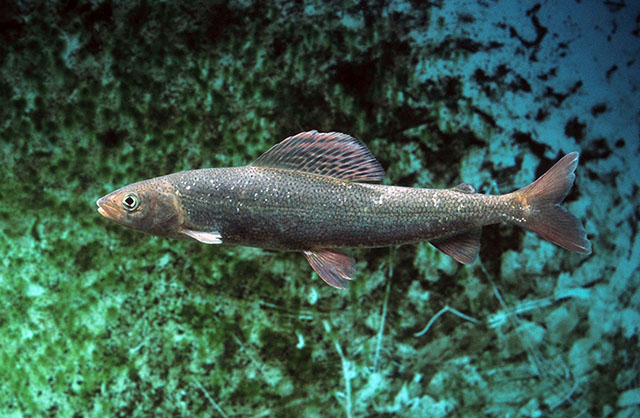| Salmonidae (Salmonids), subfamily: Thymallinae |
| 60 cm TL (male/unsexed); max.weight: 6,700.0 g; max. reported age: 14 years |
|
benthopelagic; freshwater; brackish; pH range: 7 - 7.5; dH range: 20; depth range - 15 m, non-migratory |
| Europe: Barent Sea basin west of Urals, Caspian, Black, Baltic, White and North Sea basins, Atlantic westward to Loire drainage; Rhône drainage; northern Adriatic basin east to Soca drainage. Introduced over most of southern and central Finland. |
|
Dorsal spines (total): 5-8; Dorsal soft rays (total): 12-17; Anal spines: 3-4; Anal soft rays: 9-10; Vertebrae: 57-61. Distinguished from Thymallus arcticus by the following unique characters: maxillary usually reaching anterior margin of eye; pelvic fin grey, lacking red stripes; body without red spots; dorsal fin greyish, with parallel rows of round dark spots; gill rakers 19-30, averaging about 24-26 (Ref. 59043). Caudal fin with 19 to 21 rays (Ref. 2196). |
| Inhabits submontane reaches of rivers with a hard sand or stone bottom and well oxygenated, cold and fast-flowing water (Ref. 59043). Prefers running, well-oxygenated waters of rivers (Ref. 30578). In Scandinavia, it occurs in clear lakes and freshened part of northern Baltic basin. Usually lives in hollows behind boulders and shaded water under overhanging vegetation (Ref. 59043). Gregarious, forms schools (Ref. 2196). Feeds mainly on insects (Ref. 9696), nymphs, small worms and crustaceans (Ref. 30578). Breeds in shallow stretches, usually 20-40 cm deep, or riffles, with moderate current of about 0.5 m/s and clean gravel bottom (Ref. 59043). Can be captured with natural bait (insect larvae) or with artificial fly. Very sensitive to pollution (Ref. 30578). |
|
Least Concern (LC); Date assessed: 05 March 2010 Ref. (130435)
|
| harmless |
|
Is likely to benefit from environmental regulations passed on 8/12/88 in France. Indigenous in the basins of the Rhine, the Rhône and in a still unexplained way, in the Loire. Included in Annex V of the Directive Habitats Faune-Flore (Ref. 11941). Present in some sites of the Seine and the Garonne (Ref. 30578). In "Annexe III de la Convention de Berne" (Ref. 40476).
Status of threat: Vulnerable (Ref. 74334). |
Source and more info: www.fishbase.org. For personal, classroom, and other internal use only. Not for publication.

